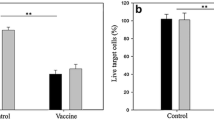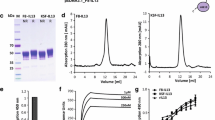Summary
A number of studies have demonstrated that potent anti-tumor immunity can be induced using cytokine gene transfer, a strategy termed transgenic immunotherapy. Our aim is to express cytokine genes in the vicinity of tumor cells, either by transducing tumor cells themselves, or by delivering cytokine-expressing endothelial cells to tumor sites. We compared the ability of cytokine-expressing tumor cells or endothelial cells to inhibit the tumorigenesis of MDA-MB-435 breast cancer cells in athymic nude mice. Retroviral vectors containing either human interleukin 2 (hIL-2) or interleukin 1 (hIL-1α) were used to transduce MDA-MB-435 cells or human umbilical vein endothelial cells (HUVEC). Using a modified MTT bioassay and an ELISA specific for hIL-2, 43 of 70 MDA-MB-435 clones transduced with IL-2 were found to secrete between 100–800 units of IL-2/106 cells/24 hr. hIL-2 and hIL-1α-transduced HUVEC secreted 40 ng/IL-2/106/24 hr and 1.8 ng/106/24 hr, respectively. To facilitatein vivo tracking of tumor cells, both nontransduced and IL-2-expressing MDA-MB-435 cells were genetically-marked with the E. colilacZ gene and selected using flow cytometry. To studyin vivo tumorigenicity, cells were injected into the mammary fat pad of athymic nude mice: (1)lacZ/MDA-MB-435 cells injected alone formed tumors in all animals ;(2) IL-2-expressinglacZ/MDA-MB-435 cells did not form any tumors; (3) co-inoculation of MDA-MB-435/IL-2, HUVEC/IL-2, or HUVEC/IL-1α withlacZ/MDA-MB-435 cells prevented or delayed tumor growth. These results suggest that local cytokine secretion was capable of activating natural killer cell activity in host animals. Transgenic immunotherapy is a promising approach that may be useful for the eradication of minimal residual disease.
Similar content being viewed by others
References
Oettgen H, Old LJ: The history of cancer immunotherapy. In: DeVita Jr VT, Hellman S, Rosenberg SA (eds) Biologic therapy of cancer. Philadelphia, New York, London, Hagerstown: Lippincott, 1991, pp 87–119
Rosenberg SA, Lotze MT, Muul LMet al.: A progress report on the treatment of 157 patients with advanced cancer using lymphokine-activated killer cells and interleukin-2 or highdose interleukin-2 alone. N Engl J Med 316: 889–897, 1987
Hui KM, Sim T, Foo TT, Oei AA: Tumor rejection mediated by transfection with allogeneic class I histocompatibility gene. J Immunol 143: 3835–3843, 1989
Kim TS, Russell SJ, Collins MK, Cohen EP: Immunity to B16 melanoma in mice immunized with IL-2-secreting allogeneic mouse fibroblasts expressing melanoma-associated antigens. Int J Cancer 51: 283–289, 1992
Davidoff AM, Kerns BJ, Iglehart JD, Marks JR: Maintenance of p53 alterations throughout breast cancer progression. Cancer Res 15: 1573–1579, 1991
Robbins PF, Eggensperger D, Qi CF, Schlom J: Definition of the expression of the human carcinoembryonic antigen and non-specific cross-reacting antigen in human breast and lung carcinomas. Int J Cancer 53: 892–897, 1993
Kantor J, Irvine K, Abrams Set al.: Immunogenicity and safety of a recombinant vaccinia virus vaccine expressing the carcinoembryonic antigen gene in a nonhuman primate. Cancer Res 52: 6917–6925, 1992
Brünner N, Thompson EW, Spang-Thomsen M, Rygaard J, Dan K, Zwiebel JA: lacZ transduced human breast cancer xenografts as anin vivo model for the study of invasion and metastasis. Eur J Cancer 28A: 1989–1995, 1992
Kurebayashi J, McLeskey SW, Johnson MD, Lippman ME, Dickson RB, Kern FG: Quantitative demonstration of spontaneous metastasis by MCF-7 human breast cancer cells cotransfected with fibroblast growth factor 4 and lacZ. Cancer Res 53: 2178–2187, 1993
McLeskey SW, Kurebayashi J, Honig SFet al.: Fibroblast growth factor 4 transfection of MCF-7 cells produces cell lines that are tumorigenic and metastatic in ovariectomized or tamoxifen-treated athymic nude mice. Cancer Res 53: 2168–2177, 1993
Lin WC, Pretlow TP, Pretlow TG, Culp LA: Bacterial lacZ gene as a highly sensitive marker to detect micrometastasis formation during tumor progression. Cancer Res 50: 2808–2817, 1990
Lin WC, Pretlow TP, Pretlow TG, Culp LA: Development of micrometastases: earliest events detected with bacterial lacZ gene-tagged tumor cells. J Natl Cancer Inst 82: 1497–1503, 1990
Jain VK, Magrath IT: A chemiluminescent assay for quantitation of β-galactosidase in the femtogram range: application to quantitation of β-galactosidase in lacZ-transfected cells. Anal Biochem 199: 119–124, 1991
Nolan GP, Fiering S, Nicolas J-F, Herzenberg LA: Fluorescence-activated cell analysis and sorting of viable mammalian cells based on beta-D-galactosidase activity after transduction of Escherichia coli lacZ. Proc Natl Acad Sci USA 85: 2603–2607, 1988
Miller AD, Rosman GJ: Improved retroviral vectors for gene transfer and expression. Biotechniques 7: 980–2, 984-6, 1989
Markowitz DG, Goff SP, Bank A: Safe and efficient ecotropic and amphotropic packaging lines for use in gene transfer experiments. Trans Assoc Am Physicians 101: 212–218, 1988
Miller AD, Buttimore C: Redesign of retrovirus packaging cell lines to avoid recombination leading to helper virus production. Mol Cell Biol 6: 2895–2902, 1986
Morgan RA, Anderson WF: PCR and other test systems in human gene therapy. Dev Biol Stand 76: 171–177, 1992
Price JE, Polyzos A, Zhang RD, Daniels LM: Tumorigenicity and metastasis of human breast carcinoma cell lines in nude mice. Cancer Res 50: 717–721, 1990
Gansbacher B, Zier K, Daniels B, Cronin K, Bannerji R, Gilboa E: Interleukin 2 gene transfer into tumor cells abrogates tumorigenicity and induces protective immunity. J Exp Med 172: 1217–1224, 1990
Fearon ER, Pardoll DM, Itaya Tet al.: Interleukin-2 production by tumor cells bypasses T helper function in the generation of an antitumor response. Cell 60: 397–403, 1990
Russell SJ, Eccles SA, Flemming CL, Johnson CA, Collins MK: Decreased tumorigenicity of a transplantable rat sarcoma following transfer and expression of an IL-2 cDNA. Int J Cancer 47: 244–251, 1991
Cavallo F, Giovarelli M, Gulino Aet al.: Role of neutrophils and CD4+ T lymphocytes in the primary and memory response to nonimmunogenic murine mammary adenocarcinoma made immunogenic by IL-2 gene. J Immunol 149: 3627–3635, 1992
Gansbacher B, Zier K, Cronin Ket al.: Retroviral gene transfer induced constitutive expression of interleukin-2 or interferon-gamma in irradiated human melanoma cells. Blood 80: 2817–2825, 1992
Gastl G, Finstad CL, Guarini Aet al.: Retroviral vector-mediated lymphokine gene transfer into human renal cancer cells. Cancer Res 52: 6229–6236, 1992
Bubeník J, Lotzová M, Símová J, Jandlová T, Bubeníková D: Use of IL-2 gene transfer in local immunotherapy of cancer. Cancer Lett 62: 257–262, 1992
Golumbek PT, Lazenby AJ, Levitsky Het al.: Treatment of established renal cancer by tumor cells engineered to secrete interleukin-4. Science 254: 713–716, 1991
Tepper RI, Coffman RL, Leder P: An eosinophil-dependent mechanism for the antitumor effect of interleukin-4. Science 257: 548–551, 1992
Tepper RI, Levinson DA, Stanger BZ, Campos-Torres J, Abbas AK, Leder P: IL-4 induces allergic-like inflammatory disease and alters T cell development in transgenic mice. Cell 62: 457–467, 1990
Porgador A, Brenner B, Vadai E, Feldman M, Eisenbach L: Immunization by gamma-IFN-treated B16-F10.9 melanoma cells protects against metastatic spread of the parental tumor. Int J Cancer Suppl 6: 54–60, 1991
Porgador A, Tzehoval E, Katz Aet al.: Interleukin 6 gene transfection into Lewis lung carcinoma tumor cells suppresses the malignant phenotype and confers immunotherapeutic competence against parental metastatic cells. Cancer Res 52: 3679–3686, 1992
Sun WH, Kreisle RA, Phillips AW, Ershler WB.In vivo andin vitro characteristics of interleukin 6-transfected B16 melanoma cells. Cancer Res 52: 5412–5415, 1992
Restifo NP, Spiess PJ, Karp SE, Mulë JJ, Rosenberg SA: A nonimmunogenic sarcoma transduced with the cDNA for interferon gamma elicits CD8+ T cells against the wild-type tumor: correlation with antigen presentation capability. J Exp Med 175: 1423–1431, 1992
Gansbacher B, Bannerji R, Daniels B, Zier K, Cronin K, Gilboa E: Retroviral vector-mediated gamma-interferon gene transfer into tumor cells generates potent and long lasting antitumor immunity. Cancer Res 50: 7820–7825, 1990
Plaskin D, Gelber C, Feldman M, Eisenbach L: Reversal of the metastatic phenotype in Lewis lung carcinoma cells after transfection with syngenic H-2Kb gene. Proc Natl Acad Sci USA 85: 4463–4467, 1988
Asher AL, Mulé JJ, Kasid Aet al.: Murine tumor cells transduced with the gene for tumor necrosis factor-α: evidence for paracrine immune effects of tumor necrosis factor against tumors. J Immunol 146: 3227–3234, 1991
Colombo MP, Ferrari G, Stoppacciaro Aet al.: Granulocyte colony-stimulating factor gene transfer suppresses tumorigenicity of a murine adenocarcinomain vivo. J Exp Med 173: 889–897, 1991
Dranoff G, Jaffee E, Lazenby Aet al.: Vaccination with irradiated tumor cells engineered to secrete murine granulocyte-macrophage colony-stimulating factor stimulates potent, specific, and long-lasting anti-tumor immunity. Proc Natl Acad Sci USA 90: 3539–3543, 1993
Mosmann T: Rapid colorimetric assay for cellular growth and survival: Application to proliferation and cytotoxicity assays. J Immunol 65: 55–63, 1983
Author information
Authors and Affiliations
Rights and permissions
About this article
Cite this article
Su, N., Ojeifo, J.O., MacPherson, A. et al. Breast cancer gene therapy: transgenic immunotherapy. Breast Cancer Res Tr 31, 349–356 (1994). https://doi.org/10.1007/BF00666167
Issue Date:
DOI: https://doi.org/10.1007/BF00666167




